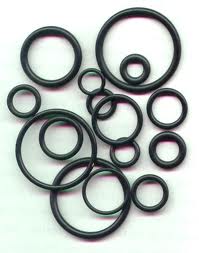Before we get into a more detailed discussion of O-Rings you should spend one minute to read this interesting article on the basics and history of the humble O-Ring here… https://fuziontrading.co.za/the-o-ring/
 Measuring O-Rings
Measuring O-Rings
The O-Ring is, in most cases, measured in the ID and the cross section, e.g. 25 x 2.5 which indicates that the ID is 25mm and the OD is 30mm
Size Standards of O-Rings
O-rings have a few size standards, e.g. British, Japanese…but the most popular worldwide is the “dash” number (-213) which is the Aerospace Standard who assign a dash number and tolerances to each size.
Tolerance of O-Rings
O-Rings cannot be made to exact dimensions every time. Various rubber compounds, the manufacturing process and other factors cause variations and shrinkage during the curing process will affect the exact size of the finished product. Note that tolerance play a major part in seal design and the tolerances of various O-Ring materials need to be ascertained.
Elastomers
The rubber O-Ring is the most common, while plastic and metal is also available. The market offers 36 different rubber compounds for various temperatures, chemical exposure, aggressive compounds and much more. When purchasing O-Rings it is imperative to give your supplier all the details of where and how the O-Ring is to be used. E.g. Nitrile works well with oil and grease but cannot last long in sunlight. Temperature is extremely important when selecting the correct material, e.g. Nitrile works well at minus temperatures while Silicone is good for very high temperatures.
Shore Hardness of O-Rings
This is further consideration when choosing the correct O-Ring. Applications demand the correct shore hardness in most cases. This may be trial and error in the testing stage of a new application, but the correct shore hardness is essential to productivity. The durometer reading is normally increased at 5 durometer points from very soft to hard. The hardness of rubber is very difficult to control during manufacturing process, even for the most sophisticated plants. Manufacturers of O-Rings require a tolerance of +/- 5 durometer points. The most common O-Ring in use for a wide range of applications is the 70 shore Nitrile O-Ring.
Learning which O-Rings are best
It would be impossible to give you all the permutations regarding the correct elastomers for the application in this article. I therefore suggest you contact your O-Ring professional or Google “Elastomer Characteristics Chart” for detailed information.
It is paramount that you purchase your sealing requirements, including O-Rings, from a professional supplier who can assist with the correct product for the application.
FUZION TRADING expertise has over many years, successfully assisted customers from giant industrial corporations to the sole operator with the selection of the correct product for the application.
FUZION TRADING is proud to be associated with GAPI of Italy to bring you the best O-Rings money can buy.



